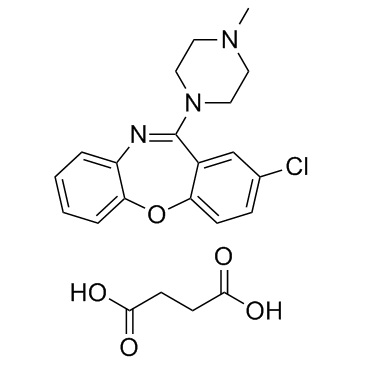Loxapine succinate

Loxapine succinate structure
|
Common Name | Loxapine succinate | ||
|---|---|---|---|---|
| CAS Number | 27833-64-3 | Molecular Weight | 445.896 | |
| Density | N/A | Boiling Point | 458.6ºC at 760mmHg | |
| Molecular Formula | C22H24ClN3O5 | Melting Point | 150-152°C | |
| MSDS | Chinese USA | Flash Point | 231.1ºC | |
Use of Loxapine succinateLoxapine Succinate is a D2DR and D4DR inhibitor, serotonergic receptor antagonist and also a dibenzoxazepine anti-psychotic agent.IC50 value: Target: D2DR/D4DR; 5-HT receptorin vitro: In the presence of Loxapine, [3H]ketanserin binds to 5-HT2 receptor in Frontal cortex of brain in human and bovine with ki value of 6.2 nM and 6.6 nM, respectively. Loxapine has the rank order of potency for the various receptors appears to be as follows:5-HT2≥D4>>>D1>D2 in comparing competition experiments involving the human membranes [1]. Loxapine 0.2 μM, 2 μM and 20 μM reduces IL-1beta secretion by LPS-activated mixed glia cultures after 1 and 3 days of exposure. Loxapine in concentrations of 0.2 μM, 2 μM and 20 μM reduces IL-2 secretion in mixed glia cultures after 1 and 3 days of exposure, and additionally Loxapine decreases IL-1beta and IL-2 secretion in LPS-induced microglia cultures in concentrations of 2 μM, 10 μM and 20 μM [2].in vivo: Loxapine (5 mg/kg) induces a very significant reduction (more than 50%) of serotonin (S2) receptor density after 4 weeks or 10 weeks of daily injection in the rat. Loxapine (5 mg/kg) does not change dopamine receptor density but greatly reduces serotonin receptor density by 47% in the brain of rats [3]. |
| Name | loxapine succinate |
|---|---|
| Synonym | More Synonyms |
| Description | Loxapine Succinate is a D2DR and D4DR inhibitor, serotonergic receptor antagonist and also a dibenzoxazepine anti-psychotic agent.IC50 value: Target: D2DR/D4DR; 5-HT receptorin vitro: In the presence of Loxapine, [3H]ketanserin binds to 5-HT2 receptor in Frontal cortex of brain in human and bovine with ki value of 6.2 nM and 6.6 nM, respectively. Loxapine has the rank order of potency for the various receptors appears to be as follows:5-HT2≥D4>>>D1>D2 in comparing competition experiments involving the human membranes [1]. Loxapine 0.2 μM, 2 μM and 20 μM reduces IL-1beta secretion by LPS-activated mixed glia cultures after 1 and 3 days of exposure. Loxapine in concentrations of 0.2 μM, 2 μM and 20 μM reduces IL-2 secretion in mixed glia cultures after 1 and 3 days of exposure, and additionally Loxapine decreases IL-1beta and IL-2 secretion in LPS-induced microglia cultures in concentrations of 2 μM, 10 μM and 20 μM [2].in vivo: Loxapine (5 mg/kg) induces a very significant reduction (more than 50%) of serotonin (S2) receptor density after 4 weeks or 10 weeks of daily injection in the rat. Loxapine (5 mg/kg) does not change dopamine receptor density but greatly reduces serotonin receptor density by 47% in the brain of rats [3]. |
|---|---|
| Related Catalog | |
| References |
| Boiling Point | 458.6ºC at 760mmHg |
|---|---|
| Melting Point | 150-152°C |
| Molecular Formula | C22H24ClN3O5 |
| Molecular Weight | 445.896 |
| Flash Point | 231.1ºC |
| Exact Mass | 445.140442 |
| PSA | 102.67000 |
| LogP | 3.01860 |
| Storage condition | -20°C Freezer |
| Water Solubility | H2O: soluble |
CHEMICAL IDENTIFICATION
HEALTH HAZARD DATAACUTE TOXICITY DATA
|
| Personal Protective Equipment | Eyeshields;Gloves;type N95 (US);type P1 (EN143) respirator filter |
|---|---|
| Hazard Codes | Xi |
| RIDADR | UN 2811 6.1 / PGII |
| WGK Germany | 3 |
| RTECS | WM5750000 |
|
Investigation of the disposition of loxapine, amoxapine and their hydroxylated metabolites in different brain regions, CSF and plasma of rat by LC–MS/MS
J. Pharm. Biomed. Anal. 58 , 83-93, (2012) Loxapine represents an interesting example of old “new” drug and is recently drawing attention for its novel inhalation formulation for the treatment of both psychiatric and non-psychiatric disorders.... |
|
|
In vitro aerosol characterization of Staccato(®) Loxapine.
Int. J. Pharm. 403(1-2) , 101-8, (2011) Medicinal aerosol products (metered dose and dry powder inhalers) require characterization testing over a wide range of use and pre-operating stress scenarios in order to ensure robust product perform... |
|
|
Inhaled loxapine for agitation revisited: focus on effect sizes from 2 Phase III randomised controlled trials in persons with schizophrenia or bipolar disorder.
Int. J. Clin. Pract. 66(3) , 318-25, (2012) To describe the efficacy of inhaled loxapine for the treatment of agitation associated with schizophrenia or bipolar disorder using different examples of effect size (ES).Psychopharmacologic Drug Advi... |
| 2-Chloro-11-(4-methylpiperazin-1-yl)dibenzo[b,f][1,4]oxazepine succinate (1:1) |
| Succinic acid - 2-chloro-11-(4-methyl-1-piperazinyl)dibenzo[b,f][1,4]oxazepine (1:1) |
| Daxolin |
| Butandisäure--2-chlor-11-(4-methylpiperazin-1-yl)dibenzo[b,f][1,4]oxazepin(1:1) |
| loxapine succinate salt |
| acide butanedioïque - 2-chloro-11-(4-méthylpipérazin-1-yl)dibenzo[b,f][1,4]oxazépine (1:1) |
| MFCD00069298 |
| Loxitane |
| Cloxazepin |
| Dibenz[b,f][1,4]oxazepine, 2-chloro-11-(4-methyl-1-piperazinyl)-, butanedioate (1:1) |
| Loxapac |
| EINECS 248-682-0 |
| butanedioic acid,8-chloro-6-(4-methylpiperazin-1-yl)benzo[b][1,4]benzoxazepine |
| 2-chloro-11-(4-methylpiperazin-1-yl)dibenzo[b,f][1,4]oxazepine butanedioate |
| Lederle |
| 2-Chloro-11-(4-methyl-1-piperazinyl)dibenzo[b,f][1,4]oxazepine succinate |
| Loxapine succinate |
| Loxapine (succinate) |

